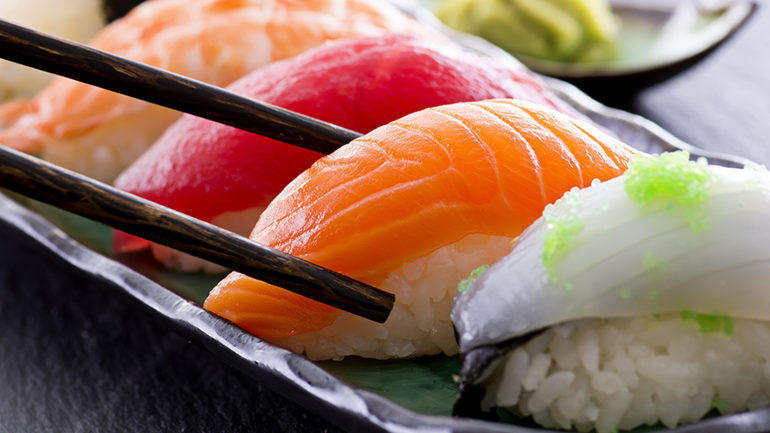
Going on a health kick with your chopsticks. Our dietitian shares tips on healthier choices for your next sushi craving.
Sushi is a food staple here on the West Coast. Beloved by many and available on almost any street, sushi is clearly popular, but is it a healthy food choice? You might have heard that Japanese diets are very healthy, or that fish is good for you, and while that may generally be true, not all foods – or sushi rolls – are created equal.
So when you’re trying to eat healthy: to roll or not to roll, that is the question. The answer? Pick your rolls carefully.
Here are some popular choices at Japanese restaurants to give you an idea of the nutrition in your average sushi order
|
Item |
Protein |
Carbohydrate |
Fat |
Calories |
|
Kappa roll (6pc) |
3g |
18g |
1g |
90kcal |
|
Salmon Nigiri (1pc) |
7g |
8g |
2g |
80kcal |
|
Tuna Nigiri |
9g |
8g |
0.3g |
70kcal |
|
California roll |
9g |
29g |
9g |
230kcal |
|
Dynamite roll |
7g |
29g |
10g |
230kcal |
|
Rainbow roll |
14g |
28g |
6g |
220kcal |
NOTE: Actual values may vary slightly depending on the restaurant, ingredients and portion size.
While kappa rolls are simple, tasty, and low in fat, there is not a whole lot of nutrition in them. In a single six-piece order, most of your macronutrients come from white rice or carbohydrate, about 26 grams to be specific. The amount of cucumber isn’t enough to count as a full vegetable serving, which is half a cup.
What about the salmon and tuna nigiri? These have a more significant amount of protein (about 6 grams), and salmon and cold water fish like tuna also contain good Omega-3 fats. But there are no extra nutrients from vegetables, so adding some gomae (cooked spinach, light on the sesame sauce) to your order would make for a more well-balanced meal.
Specialty sushi rolls are where your menu choices can result in less than healthy meals. Most rolls, especially the colorful ones, have a variety of sauces, many of which are based on mayonnaise, or they include deep-fried items, and as a result are generally much higher in calories and fat. Ask for your rolls without, or with less, finishing sauce to cut the calories and chose them less often. ealthy picks
Starters
- Tea: sip on tea instead of a bowl of high-sodium, low nutrient miso soup
- Seaweed salad (wakame): high in magnesium and iron
- House salad: eating more leafy veggies never hurt, and they’re a great source of fibre
- Edamame: high in protein, great to munch before the main course, but hold the extra salt
Mains
- Vegetarian roll: packed with veggies, carrots, cucumber, mushrooms, daikon to boost the macronutrients in your meal
- Salmon and avocado roll: high protein and omega-3 fatty acids
- Avocado roll: abetter vegetarian choice than a fried yam tempura roll
- Low sodium soy sauce: better option over regular soy sauce, use sparingly
- Ebi (shrimp) nigiri: high protein, low in fat
- Tamago (egg) nigiri: high protein, and low fat
- Teriyaki: lean meats such as chicken are a lower fat alternative to tonkatsu or chicken katsu
- Sashimi: more protein from the fish will keep you fuller for longer
- Brown rice: if there’s an option to substitute brown rice for white, don’t pass it up
Simple tips
So is sushi always going to be a healthy option? Like so many things, it depends on which options you choose. Compared to a typical burger and fries, sushi will be a much lower fat alternative, and you have more options for leaner protein choices such as a variety of fish. So next time you’re craving sushi remember these simple tips to keep your meal healthy and roll on!
- Choose dishes with fewer carbohydrates such as a starter salad, edamame or enjoy an extra cup of tea
- Opt for rolls with fewer sauces
- Switch your rolls to use brown rice instead of white rice whenever possible
- Limit deep-fried items like tempura
